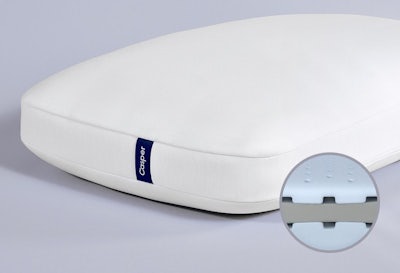
How To Sleep With Back Pain:
5 Tips for Relief
3/24/2020 | Casper Editorial Team
Back pain is an acute medical condition that causes physical mobility limitations in everyday life. The sudden onset can last up to six weeks before an individual finds relief.
Considered one of the leading causes of musculoskeletal disabilities worldwide, back pain is a common trigger for the problem. More specifically, about 80 percent of adults experience low back pain at some point. While it’s generally a short-term impairment, if the problem isn’t resolved, it can lead to chronic issues.
The limitations caused by back pain can affect the completion of everyday tasks and activities. The Mayo Clinic cited radiating and shooting pains, muscle stiffness and strains as well as the need to lay in a reclined position as common signs and symptoms of back pain.
The days that you have to roll yourself out of the bed shouldn't be taken lightly. It's important to recognize when something is going on “back there” and how to troubleshoot the situation. In this post, we’ll focus on how to sleep with back pain and remedies that can help resolve bedtime discomfort.
How Does Back Pain Affect Sleep?
Acute and chronic back pain can cause insomnia, a sleep disorder characterized by trouble falling and staying asleep at night. Back pain disrupts the sleep cycle and prevents you from reaching REM sleep (rapid eye movement), the fifth and deepest stage of sleep. Missing one to two hours of quality sleep sends you into sleep deprivation, and can affect your brain function, mood and overall judgment throughout the day.
The Center for Disease Control and Prevention (CDC) recommends seven to nine hours of sleep for the average adult. When thinking about your normal sleep schedule, here are the guidelines to keep in mind:

If chronic back pain is inhibiting your sleep, you may not notice sleep deprivation in the first half of the day while pounding coffee, battling traffic and meeting work deadlines. But as the day goes on and the lack of sleep sinks in, the body begins to slow down. The longer you deal with insomnia, the worse its side effects become.
While sleep statistics reveal the good, the bad and the ugly about our sleep habits, all hope is not lost! Here is our list of the best sleep positions for back pain.
The 5 Best Positions for Sleeping With Back Pain
During the day we practice healthy posture while walking and sitting. Good sleeping posture is no different. To find comfort and keep the muscles and joints healthy, it’s recommended to keep the ears, neck, spine and hips in proper alignment. This will help prevent low back pressure and could provide pain relief.
1. Side Sleeping in a Fetal Position With a Body Pillow
Side sleepers are likely already aware of the relief that comes with sleeping with a body pillow between your knees. According to the University of Rochester Medical Center, it could help with good sleeping posture, keeping the spine aligned and reducing back pain.

2. Stomach Sleeping With a Pillow Under Your Abdomen
Snoozing on your stomach isn’t a sleep expert’s first choice when it comes to sleeping positions, but it may help you sleep with back pain. Physically, it’s comparable to sleeping in a Superman plank for eight hours. But if done correctly, strategically using a pillow could alleviate some of that excess stress on the body.

3. Back Sleeping With a Pillow Under Your Knees
Sleeping on your back is considered one of the best sleeping positions because it eliminates tension in the back part of the body. If you have issues such as sleep apnea, this is a sleep position to stay away from because it can promote snoring. The position can cause a blockage in the respiratory system and forces the body to work twice as hard to breathe.

4. Reclining Back With a Pillow Underneath Your Head
We mentioned earlier that sleeping on your back keeps the body in a fully supported position. The Orthopedic Associates of St. Augustine University notes that it can help avoid unnatural curves in the neck and spine. The one caveat is that it can cause people to snore.

5. Sleeping Face Down with a Small Pillow Under Your Forehead
Sleeping face down has similar drawbacks to sleeping on your stomach, but if you add two pillows, it can help you get a good night’s rest while decreasing back pain.

Bedtime shouldn’t cause anxiety due to back pain. By implementing these tactics, they should provide some nighttime relief. While trying a new sleeping position isn’t always easy, you'll save money on chiropractic and doctor visits, and finally enjoy bedtime again. For extra comfort, you can always upgrade to a new foam pillow or the Wave mattress, our most advanced mattress with gel pods that provide targeted support for spinal alignment.







